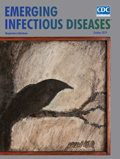
Volume 25, Number 10—October 2019
Etymologia
Etymologia: Edwardsiella tarda
Figures
Downloads
Article Metrics
In 1965, a group of CDC researchers described a species of gram-negative, facultatively anaerobic bacteria in the family Enterobacteriaceae, which they named Edwardsiella (for CDC microbiologist Philip R. Edwards) tarda (Latin, “slow,” referring to biochemical inactivity and the fact that it ferments few carbohydrates) (Figure). These organisms infect a variety of fish, reptiles, and amphibians and are opportunistic pathogens for humans.
References
- Ewing WH, McWhorter AC, Escobar MR, Lubin AH. Edwardsiella, a new genus of Enterobacteriaceae based on a new species, E. tarda. Int Bull Bacteriol Nomencl Taxon. 1965;15:33–8.
- Abbott SL, Janda JM. The genus Edwardsiella. In: Dworkin M, editor. The prokaryotes. New York: Springer; 2006. p. 72–89.
Figure
Cite This ArticleOriginal Publication Date: 9/4/2019























.png)











No hay comentarios:
Publicar un comentario